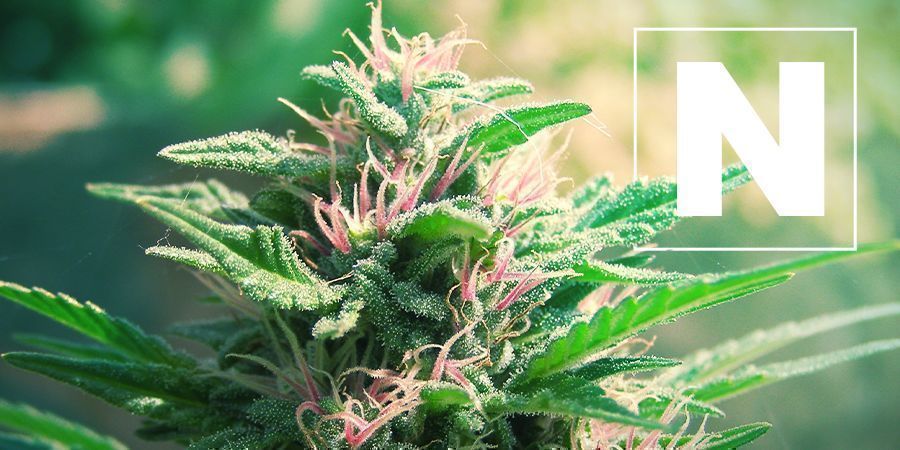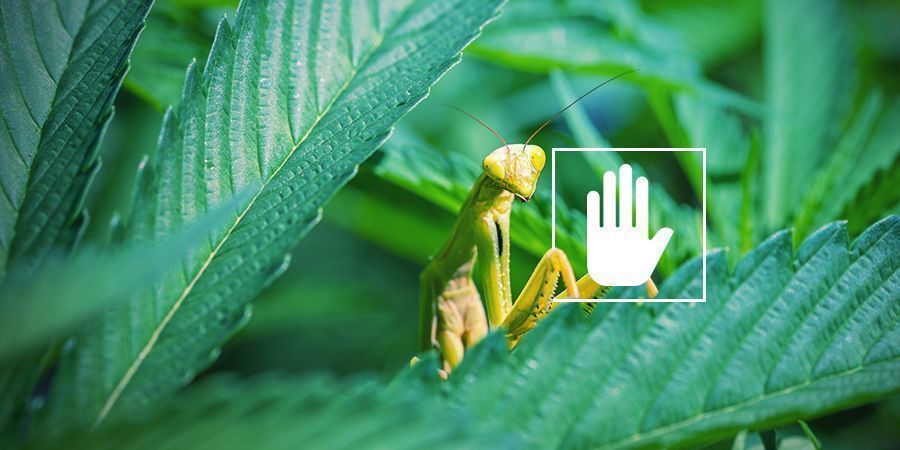The Importance Of Nitrogen For Cannabis Plants

Nitrogen is one of the three primary nutrients that all plants, including cannabis, require to grow. If your cannabis plant doesn’t get enough, or receives too much, of this important element, severe growing problems can and will occur. In this article, we take an in-depth look at all the roles nitrogen plays in cannabis cultivation.
What Is Nitrogen?

Nitrogen, the most common chemical element in our atmosphere (also abundantly found in soil and water) is vital for all living things. For plant growth, it has a particular important role as it is needed for the production of chlorophyll, the plant pigment that is essential for photosynthesis.
Nitrogen (N) is a “primary” macronutrient for cannabis because it requires abundant amounts throughout its life, with particular high requirements in the growing stage. It shares its place as an essential plant nutrient with phosphorus (P) and potassium (K), the other two primary macronutrients. Nitrogen is also a mobile nutrient. This means your cannabis plant can draw it from older leaves to new growth if there is a scarcity. This is why a nitrogen deficiency normally first shows on older leaves at the bottom.
Good soil for cannabis will always have enough nitrogen, but it’s possible for it to be present in a form that is not immediately available to the plant. In that case, it’s essential to ensure a healthy presence of microbes in the soil that can break it down.
Nitrogen Fixation
For plants to take up nitrogen, natural nitrogen in its molecular form must first undergo a process known as nitrogen fixation. In this process, molecular nitrogen (N2) that occurs naturally is converted into a form that is available to plants.
First, nitrogen from the atmosphere is deposited into soil and water through rainfall. Microorganisms in the soil are then converting it into ammonia, nitrites and nitrates which can be used by plants. There are other ways how nitrogen can be “fixed”, for example some of it happens through lightning in the atmosphere, or it can be a man-made process used for producing nitrogen-rich fertilizer.
Tip: The availability of nitrogen is dependent on pH level of the soil or water/nutrient solution. When growing in soil, nitrogen isn’t available to plants at a pH level below 5.5pH. When growing in hydro or coco, nitrogen is available at a wide range of values from 2-7.
Why Do Cannabis Plants Need Nitrogen

Cannabis needs nitrogen during its entire life cycle, although plants will need much more of it during vegetative growth. This is the reason why cannabis nutrients for “vegging” will usually have more nitrogen than flowering nutrients. The element is needed by plants to produce chlorophyll, proteins, amino acids and other important biological compounds. This is especially needed so your weed plant can grow its stem, leaves and branches. If nitrogen is not available in sufficient amounts, growing problems will occur, and your plants will most likely die.
Functions Of Nitrogen
We’ve mentioned most of these to an extent, but nitrogen functions boil down to these points:
- Essential for vegetative growth, but also needed during flowering (although at lower amounts).
- Essential for photosynthesis (chlorophyll production).
- Increases plant resistances to diseases and pests.
- Increases resistances to frost.
Needs During Early Stage
Cannabis doesn’t require nutrients in the first 2-3 weeks of growth. Not feeding early will promote the growth of roots and will benefit overall plant health. Start feeding when plants have reached a height of 15-20cm. Stick to low amounts (25-50% of recommended dosages) for the first feeds.
Needs During Vegetative Phase
From week 4 on, when your cannabis plants have entered the vegetative growing stage, they will require plenty of nitrogen, along with other essential cannabis nutrients. When using a cannabis nutrient for vegetative growth, go by the recommended feeding schedules and dosages. Know that nutrient requirements for cannabis can vary, for example, depending on the size of your plants, and how fast and vigorously they grow. A small autoflowering cannabis plant, for instance, will need less nitrogen than a large, vigorously growing feminized plant. You should also consider that overfeeding is easily possible!
Needs During Pre-Flowering
Pre-flowering occurs right before your cannabis goes into flower. In just 1-2 weeks, your plants will undergo vigorous vegetative growth, with some plants stretching considerably up to 2-3x times their current height. To accommodate this particular vigorous growth your cannabis will have maximum nutrient requirements, especially for nitrogen. The feeding schedules of commercial cannabis nutrients are usually taking this into account. Just make sure that you don’t prematurely switch to flowering nutrients before the vegetative growth of your cannabis comes to a total halt.
Needs During Flowering
When pre-flowering has commenced and vegetative growth has come to a halt, your cannabis has officially entered the flowering stage. From now on, your plants won’t grow much of anything “green” any more and will instead focus on developing their buds. Now they need less nitrogen but will want increased amounts of phosphorus and potassium. Again, good commercial flowering nutrients should accommodate this in their feeding schedules.
Tip: Nutrients for growing cannabis are typically available in two variants: one nutrient for vegetative growth, and another for flowering. Each will have the proper nutrient ratios for your cannabis depending on growing stages. This means they’ll be rich in nitrogen (N) for growth, and will have less nitrogen, but more phosphorus (P) and potassium (K), for flowering.
Nitrogen In Chemical Vs Organic Fertilizer
Nutrients for cannabis will either be mineral-based (chemical) or organic. Mineral nutrients (ie. most types of cannabis nutrients for growing in soil) provide nutrients directly to the plants, typically in a form that is readily available to the plants.
In contrast, when growing organically, one isn’t so much feeding the plants, but instead creating a suitable environment for beneficial microorganisms in the soil. Microorganisms feed on organic matter, like compost, and convert it into nutrients for the plants. Commercial (mineral) nutrients often contain nitrogen in the form of ammonium or nitrate, or both. However, growers have plenty of organic options.
Good organic sources of nitrogen include:
- Manures such as chicken manure
- Compost and other organic matter, ie. grass clippings or alfalfa pellets
- Coffee Grounds
- Legume plants (beans, peas) alongside your cannabis. Legumes convert atmospheric nitrogen gas into a biologically-available form. This makes them excellent companion plants for your cannabis.
Nitrogen Deficiency
Nitrogen deficiency is arguably one of the most common nutrient deficiencies affecting cannabis grows. It is particularly common among rookie growers working with vigorous, fast-growing strains that have a naturally high demand for nitrogen to fuel their growth. Check out our in-depth post on nitrogen deficiencies to learn exactly how to identify and address this common cannabis grower's problem.
Nitrogen Excess (Toxicity)
Nitrogen toxicity happens when your plants are exposed to more nitrogen than they are able to assimilate and use, and it is one of the most common forms of overfeeding seen among cannabis growers, especially during the transition from veg to bloom. Unfortunately, nitrogen toxicities can prove deadly to cannabis plants, so check out our dedicated post to learn how to avoid overfeeding cannabis plants with nitrogen.
Nitrogen is one of the main nutrients cannabis plants need in order to survive. Remember, however, that there's a fine line between keeping your plants well-fed and overfeeding. Striking this balance can be a challenge for growers, and only with more experience will you get closer to achieving it.












 United States
United States

.jpg)







